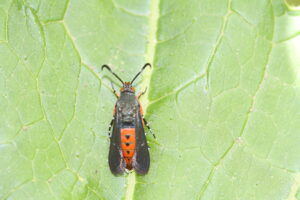In the past two weeks we have heard reports of the Squash vine borer (Figure 1) being spotted in some local gardens. This pest of cucurbit crops tends to be sporadic in our region; you are either battling it every year or it hardly makes an appearance. The squash vine borer is a member of the clear-winged moths, a unique group of moths that are active during the daytime. They are very beautiful with their bright colored orange tufts of hair. At this point in the season, we are encountering with the second generation in Indiana. The larvae feed in the ripening fruits (Figure 2). You can find holes in the fruit and sawdust-looking frass (excrement) indicating larval infestation. If you are planning to treat your crop, you need to target applications before those eggs hatch so that the larvae will ingest the spray upon hatching as they attempt to chew their way into their preferred (and protected) feeding zones inside the fruits. There are many things to consider when electing to treat with an insecticide and this time of year the window around harvest can be the most important. Those with a zero-day pre-harvest interval (PHI) include Assail and Perm-Up and others that have 1-day PHI include Warrior II and Mustang-Maxx, for pumpkin in particular. Remember, your crops are still flowering and this leaves pollinators vulnerable to the exposure of any chemical that you may choose. Consult the Midwest Vegetable Production Guide (mwveguide.org) when selecting a pesticide and be sure to check the label.
To avoid damage next year, be sure to destroy crop residues and rotate away from infested areas. A diligent scouting program in combination with pheromone traps can help detect adults during their mating flights and target application before the larvae hatch and bore into vines and fruits. Please reach out to me directly if you are interested in establishing a trapping network (lingwell@purdue.edu or (765) 494-6167). Best of luck!

